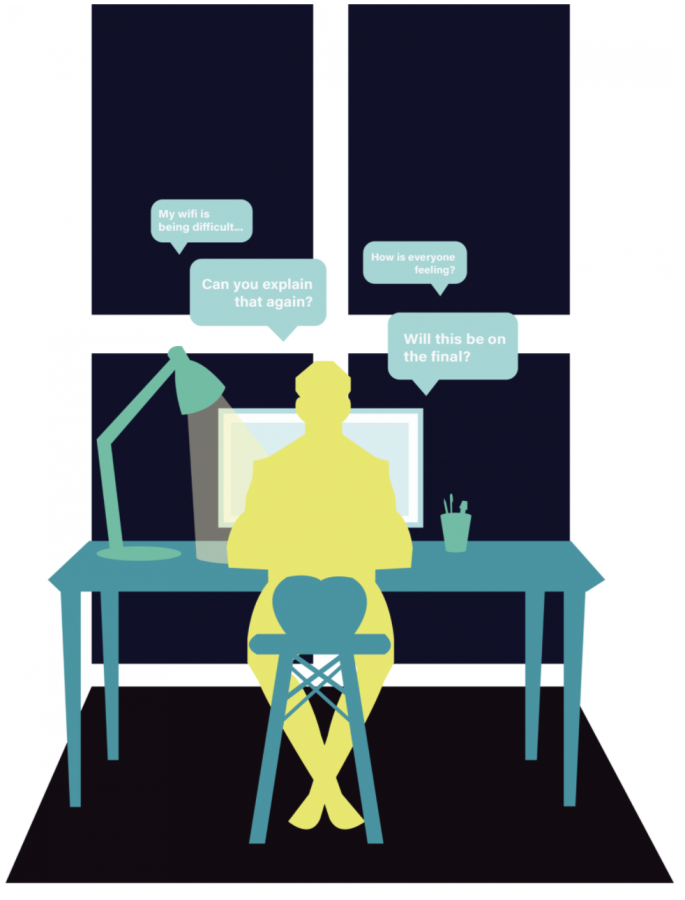Zoom is known globally as the go-to website for online schooling. Although it has made teaching accessible to millions of students, there is no doubt that the company has had its issues. Three University of Arizona professors have varying levels of frustration when it comes to teaching via Zoom. On a scale from one to 10, 10 being the most frustrated with Zoom, the professors’ answers varied from three to 10 to saying that it depends on the day.
One of the biggest frustrations with trying to communicate with students through Zoom is the strong disconnect between students and their professors. According to chemistry professor Lani Hidalgo, “Most [students] don’t use their cameras and don’t say much so I have absolutely no feedback at all. If a student is shy, I can usually read their face to determine how to proceed, now I have nothing. I also miss interacting with my students in general.”
Hidalgo is used to walking around during her lectures and talking to her students one on one. Her 600-plus class size did not hold her back from directly helping individuals and keeping everyone connected through using whiteboards and taking polls.
“It is hard to gauge how well students are understanding the discussion. Normally, you can tell from body language and facial expressions how comfortable they feel with the material,” said Michael Marty, a biochemistry and chemistry instructor.
Marty also struggles with displaying mathematical equations via Zoom as he is used to writing the formulas on a whiteboard. Now he has to convert that style of learning to oral presentations.
RELATED: New research shows that pain relief from coronavirus may explain large asymptomatic crowd
John Pollard, an Associate Dean of the UA Honors College and Biochemistry and Chemistry professor, said he believes students are more comfortable with answering questions online than in person. Yet, there are some notions to consider, such as, “Zoom cannot replace the experience of all being in a room together, working on developing thinking and engaging with the content.”
The primary challenge with trying to figure out how to teach such hands-on STEM courses ranges from using alternatives to whiteboards to translating valuable lab experience to similar learning through online programs.
Although there was a prodigious amount of adapting needed to be done, there are some benefits to teaching on Zoom. Marty said he believes even though it is harder to connect with students, “it has given the opportunity to do some demonstrations that would be challenging in a larger classroom. With Zoom, I can bring the camera close so that every student gets to see.”
Hidalgo and Pollard have similar perspectives, as they both struggle with a loss of engagement. When it comes to whether or not labs should be in person, Hidalgo said they should be. Pollard also agreed having virtual labs is not ideal for grasping concepts best learned hands-on.
As for whether the professors thought their students were learning more or less through Zoom, they unanimously agreed it depends on the type of person. Through observation, Pollard has seen “it is a very stressful time, and having students in class is the best-case scenario.” However, he also said he was “so impressed with the amazing attitudes my students have shown. One thing I have learned is that our University of Arizona students have a lot of resilience.”
With the pandemic, the world may never be the same in terms of learning. According to Pollard, we should look at this as a positive. “Things will never be as they were pre-pandemic and that is a good thing. As Winston Churchill said, ‘Never let a good crisis go to waste,’” Pollard said.
Zoom may not be the best way to learn, yet it has given professors a platform to connect with their students. Some may deem Zoom a proper learning environment, but it is easy to see that students may struggle with online learning.
Marty has described the Zoom environment as: “It may not be as good, but it can give a proper learning environment.”
Hidalgo, on the other hand, said, “If the instructor posts videos for the students to watch with no synchronous session, that will impede learning. Or if students just turn their camera off and don’t pay attention, that will certainly not help learning. It is really a give and take from both sides.”
Both students and teachers have to face their battles with communicating via Zoom. It is the individual’s duty to make an effort in this new world. Adapting is key.
Follow Briana Aguilar on Twitter









